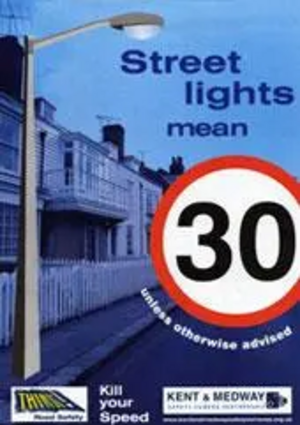Sandgate Streetlights: Not Just a Modern Fad

Kent County Council are finalising proposals to remove over 3,000 streetlights across Kent, including over 200 in Shepway.
Kent justifies this decision (and they claim it is a decision, not a consultation) on the basis that it saves energy and money. They add that when the County Council budget was consulted on, many people backed the view that unnecessary streetlights, such as those on Thanet Way, should be removed.
Of course they did. Unnecessary lights SHOULD be removed. Who could argue that point? But NECESSARY and useful lights should not. And Kent's proposals plan to get rid of many such lights. I could also add that the County Council budget consultation had an appalling low feedback figure: and doesn't really justify the name "consultation" given the way most questions were worded, but I digress.
I'm not against cutting energy use and spending: far from it. A proper approach to this process would have been to have an open consultation with each Distrcy, Town and Parish council in Kent, seeking a target energy reduction from each, and offering a series of options (including part time lighting, dimming, selective column removal and more). Those Councils could then have come back with proposals to meet the target - some may even have exceeded them! But no: Kent thinks it knows best, and plans to impose its own scheme.
In Folkestone West, the plans include the removal of lights from:
A259 (34 lights) Sandgate Esplanade
A259 (6 lights) Sandgate Hill
A20 (54 lights) J12 M20 to Peene
I fully intend to do all I can to halt these removals - permanently. At the very least, if these proposals are to go ahead then the lights in question should simply be turned off for a period. If I'm right, and they prove to be required after all, then they could simply be turned back on. But no - Kent want to remove them: immediate and irrevocably, at huge cost. That's insane.
But case by case, we need to disprove the case for each scheme. The statement by Kent County Council says:
"They are far in excess of the normal lighting standards and have a disproportionate maintenance cost due to their location. They are generally located on roads leading to or out of local settlements. Lights within settlements will be retained. Site-specific risk assessments for each road have been carried out to make sure that we only remove lights that are not needed."
So it has to be proved in each case they are not above normal lighting standards, are within settlements, and that the lights are needed. Any help that can be offered with specific evidence on each of these sites would be gratefully received (please email me at tim@prater.org,uk) and I'll compile them and make sure Kent understand them.
My starting points to Kent County Council were sent a few weeks ago:
- Sandgate Esplanade - the lights are along a residential stretch of road, which includes a bar, a hotel and a pub. It is well walked at night, and along the A259 which is heavily used by traffic at all times.
- Sandgate Hill - this is a downward approach to a junction (with Coolinge Lane on which there are two schools) on which we have already installed traffic calming measures - we will now remove the lighting so people can't see them?!
- A20 approach to J12 M20: the junction into Peene is made much safer with the lights there, as is the works entrance into the Channel Tunnel, making much of that stretch of lights important for road safety. Also, a number of people walk / cycle to the Eurotunnel site entrance after dark as it's a 24 hour operation. Do we really want them to do that in the dark?
Looking at the image on this article as well, what do streetlights indicate? a 30mph zone. And what is on Sandgate Esplanade? A speed camera. So you remove the visual clue that the area is 30mph, but leave the enforcement there. Similarly on the A259 Sandgate Hill: a speed indication device is in place displaying at above 30mph, hard fought for by the local community. And if you do over 30mph, in future that device will be the only lighting that area has - but motorists could argue that due to the lack of streetlights, the limit was no longer 30mph.
Also, streetlighting is not a new, excessive measure on Sandgate Esplanade. It is very, very long standing:
Photo of streetlight on Sandgate Esplanade 1899 http://www.francisfrith.com/sandgate/photos/parade-1899_44774/
Photo of streetlights on Sandgate Esplanade 1905 http://www.francisfrith.com/sandgate/photos/gloster-terrace-1905_56950/
The Sandgate Hotel: directly on the Esplanade http://www.sandgatehotel.com/default.aspx?content=1
Sandgate Esplanade is a settlement by any terms. it has homes, businesses and a number of junctions with side streets. Those side streets are and will be lit. The road that they lead into will not.